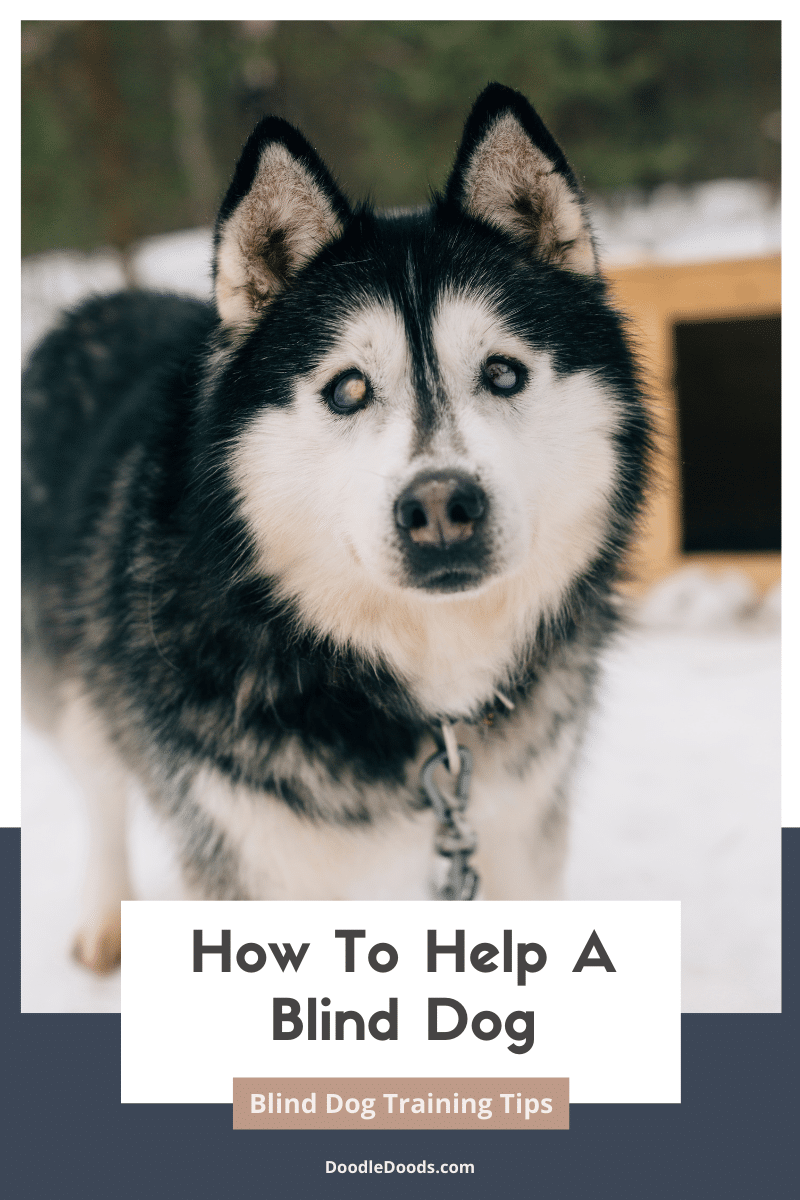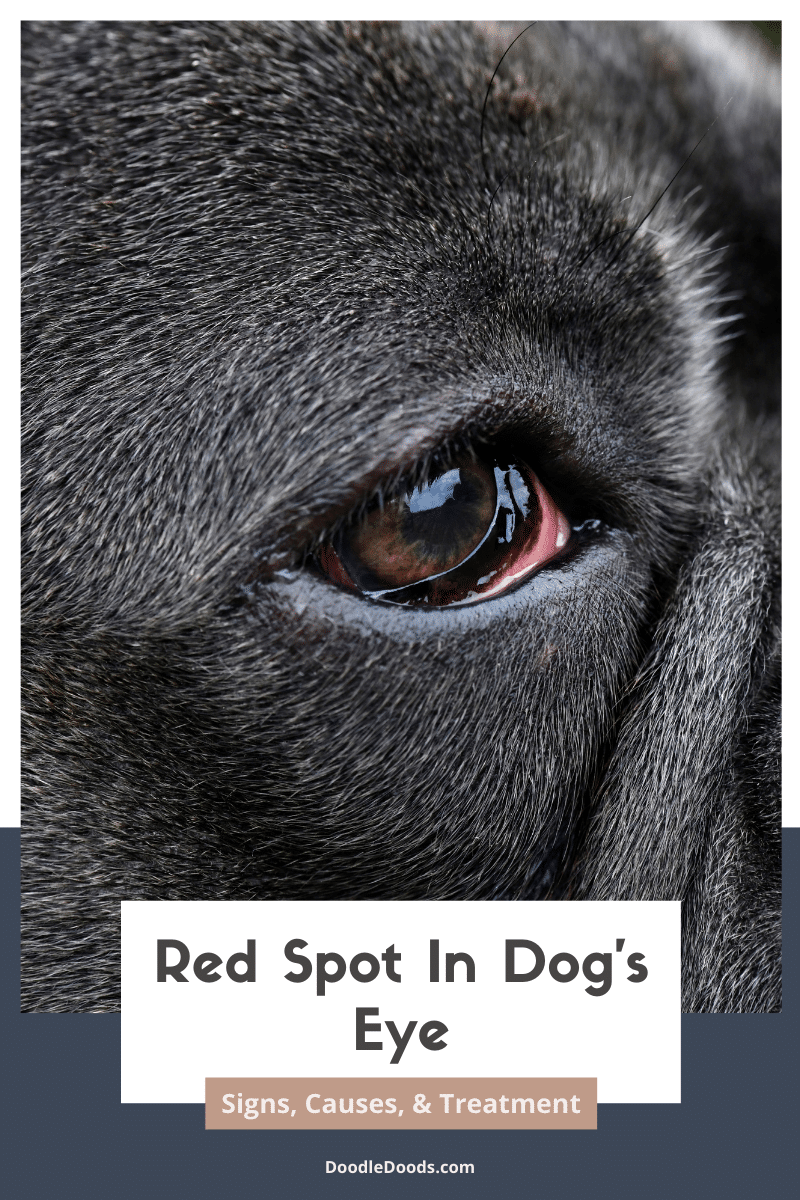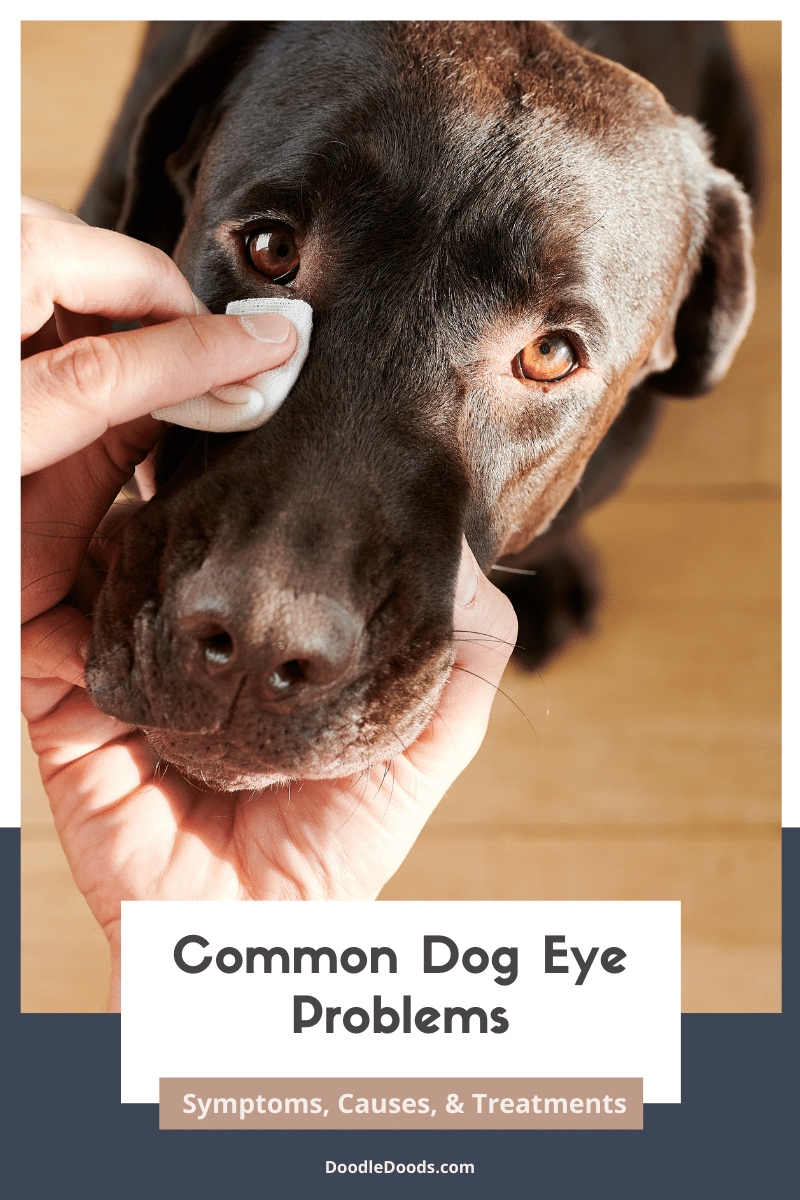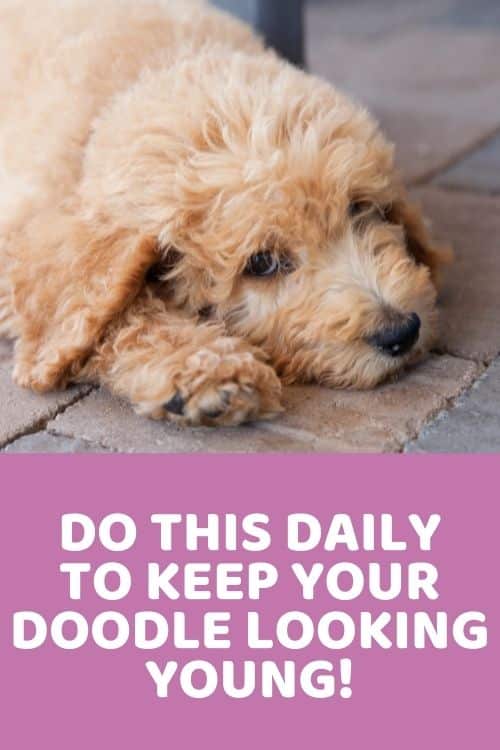In this guide, we’re going to discuss how to help a blind dog as well as share our best tips on training a blind dog. Although it’s never an easy thing having to see your precious pal lose one of its senses, it doesn’t mean that they can’t live a happy and fulfilled life by your side. With some simple lifestyle changes and daily habits, you can provide your blind dog the most loving and stress free home environment whilst they get to enjoy a comfortable life for many, many years to come.
Table of Contents
- How To Help A Blind Dog: Introduction
- How To Help A Blind Dog: Tips For Caring For A Blind Dog
- Tips On Training A Blind Dog
- How To Help A Dog Going Blind?
- How To Help A Blind Dog: Frequently Asked Questions
- How To Help A Blind Dog: Final Thoughts
How To Help A Blind Dog: Introduction
Whether you’re getting ready for the unfortunate final stage of your dog going blind or have adopted a pooch that’s already blind, caring for visually impaired pets might seem daunting at first. However, blind dogs can live just as fulfilled lives as dogs with excellent vision. You just have to know what steps to take to help your pup adjust.
Indeed, it’s never easy to talk about such serious topics, especially when they concern our four-legged best pals. On the other hand, your dog doesn’t have to suffer in the process. In fact, they might even develop heightened other senses that you can use to your dog’s advantage.
If you’ve adopted or are planning to adopt a blind dog, you probably already know what you’re in for. We’re all for adopting dogs that tend to be overlooked due to their health conditions! Some dogs are blind since birth, whereas others have experienced a trauma that’s led to blindness.
It’s also not uncommon for dogs to go blind due to certain health issues over time. Most commonly due to eye diseases like glaucoma or cataracts, or old age. Typically, the first signs you might notice include cloudy eyes, bumping into things at home, anxiety or fear of familiar places and people, or reluctance to use the stairs.
In case of the latter, your very first course of action should be to take your dog to the vet and have them properly assessed. But what if you’ve already gotten the prognosis from your veterinarian and you now have to learn how to care for a blind dog?
Well, whether your dog is going blind or has been blind for a while, this article is going to guide you through the process of how to help a blind dog to make their life as easy and comfortable as possible. Not to worry, though, it’s not at all that difficult!
How To Help A Blind Dog: Tips For Caring For A Blind Dog
In the following sections we’ll discuss how to care for a blind dog. These steps will apply both to dogs that are blind and dogs that are going blind.
Make Your Home Pup-Safe
Your first priority should be to dog-proof your home to ensure that your blind dog stays safe and won’t accidentally injure themself. If you have any sharp corners or edges at home, or even sharp objects in the house or in the backyard, all of it must either go or get covered with something that’ll keep them out of harm’s way. Soft corner coverings and bumpers are great for that. You can even utilize soft corner guards that are designed for human babies.
A helpful tip is to get down to your dog’s eye level and study what might be the potential dangers for your pet. Pay extra attention to areas that they might bump into with their face – these should all be soft and cushy!
If your home has more hazardous areas like a pool or even the stairs, you have to make sure that your dog has no access to these areas. Using dog gates is a very simple and effective way to keep your dog safe. For stairs, it might be best to install gates both at the bottom and top of the stairs to prevent your dog from falling.
Moreover, if you’ve got a smaller dog, you might want to consider keeping them away from very high traffic areas inside the house. Again, you can use pet gates to create a separate, safe area for your pup away from constant hustle and bustle, but having them still close by in a safe distance.
In fact, pet gates are perfect for keeping your dog safe when you have to run errands outside of the house while your dog stays at home. This way, you can ensure that they only have access to areas that are familiar and safe for them.
Also, if some of the rooms inside your house have slippery floors, it would be best to cover them with a rug. This also doubles as a ‘map’ of the house for your dog, but we’ll get to that in a moment.
Give Your Dog A Tour Of The House And Yard
Although it can be difficult for a blind dog to adjust to their new life and home environment at first, they tend to develop a mental map of the home quite fast. Of course, you’ll be the one helping them with that!
To help your dog develop their mental map of the house, walk them through each room and area so that they can properly understand what’s going on around them. It’s best if you have them leashed or harnessed for the duration and walk slowly. Introduce them to every corner and nook, let them sniff and inspect the areas with their other senses.
With that being said, you should also avoid rearranging the furniture so that your dog doesn’t get confused. Blindness is already confusing as it is, there’s no need to make it more stressful for your best pal. If you do, however, purchase a new furniture item, introduce it to your dog by letting them sniff and inspect it.
Keep Food And Water Bowls In The Same Place
As you can tell, the theme is getting your dog familiarized with their home and daily life. It goes without saying that you should also have your dog’s food and water bowls in the same place at all times. This is again a great way for your dog to understand what’s what and where they’re located to prevent any unnecessary confusion.
And because blind dogs tend to develop a heightened sense of smell and hearing, you can take great advantage of that. A helpful trick is to purchase an automatic water fountain that your dog can recognize by sound. Not to mention, it’s vital for any dog to have clean drinking water at all times.
Make Sure Your Dog Has A Designated Spot For Bedtime And Potty Breaks
Like with food and water bowls, you want to make the environment as easy to navigate and familiar as possible for your dog. Keep their dog beds and dog crates in the same spots so that your dog will know where to go when it’s time for a nap or bedtime. This is also an excellent way to build that extra sense of safety and security for your pet – this is their safe spot for relaxing and resting.
Similarly, if you have a backyard where your dog goes to potty, bring them to the same place each time so they know where to go. Make sure to introduce these spots to your dog when you give them a tour of the home and yard. Again, you don’t want to have a new spot or move their bed around all the time, as this defeats the whole purpose of it.
Stick To A Daily Routine
Setting a schedule for a puppy is one of the best ways to get them house trained. This helps puppies understand when they’ll be fed, when they can go potty, when it’s time for play, and so forth. It’s pretty much the same for blind dogs – the goal is to help your dog understand when they’re going to be doing something and also where they’ll be doing it.
This also applies to your dog’s daily walkies and outdoor activities. Take your dog out for a walk using the same route every day and go to the same dog park each time. This is similar to helping your dog create a mental map of the inside of the house, but this time it’s their daily routes outside. This will also greatly help with fear and anxiety when walking outside, as it’s already familiar to them.
Keep Your Floors Clean From Clutter
Needless to say, caring for a blind dog also requires you to be tidy and keep any clutter off the floors. Whether it’s your shoes, a handbag, TV remote, dirty socks, or other household objects, it’s best that everything has its own place. This will not just help your blind dog understand how to navigate around the house, it’ll also prevent any unfortunate accidents due to ingesting items they shouldn’t.
The same goes for any chairs and other objects that you might use for a little while. For instance, dining chairs and office chairs – place them back under the table after you’ve finished using them to prevent your pup from bumping into them.
Map The House With Different Textures
Textured rugs and mats are a great way to help your dog create a mental map of the home. Use different textures in different rooms so that it’s easier for your dog to understand where they are exactly. If you have a fenced backyard, you can also use sand or other natural materials to create pathways for your dog to navigate safely around the garden.
Furthermore, you can also use dog-safe scents and essential oils, or even plants to map certain rooms and areas both inside and outside the house. For instance, you can use different scents in different rooms to help your pup understand where they are. Just make sure that you’re not using large quantities and only opt for scents that are guaranteed to be safe for dogs.
Help Them Out During Social Interactions
Outdoor activities can prove to be a challenge at first, especially when meeting new people or pets on their walkies and dog park visits. Many people probably won’t even notice that your dog is blind, so it may be reasonable to let others know by having ‘I’m blind’ written on your dog’s collar or leash, or even have them wearing a bandana or jacket with the text.
You might also want to consider getting a blind dog harness to keep your pup safe when out and about. A blind dog harness has a halo that goes around your dog’s face, preventing them from bumping into objects, people, or pets when you’re out for some exercise.
By the way, if you also have other pets in your household, they might often become sort of guide pets for your blind dog. Firstly, your other dog(s) or cat(s) also leave a trail of scent behind them so that your blind dog has an easier time navigating around the house. Secondly, it’s not uncommon for the other dog in the household to become a seeing-eye-dog for your blind pet if they have a close relationship.
Regardless if you have other pets in the household or when meeting new four-legged friends outside, it’s best to first let them slowly get acquainted and sniff each other from a distance. Always keep an eye on their interactions until they’ve become actual friends and can get along well. The same goes for children in your home and outside the household.
Opt For Squeaky Toys
Blind dogs are just as playful and fun loving as dogs with good eyesight. However, it might be best if you got your dog toys that make sounds and noises. Opt for chew toys that make a squeaky sound and get some other fun, noisy toys for your pup to play with. You can also purchase treat dispensing toys for your pup to better sense where you’re throwing the toy – this also doubles as mental stimulation. Similarly, you can rub their favorite toys with their favorite doggy treats.
Regardless of your dog’s breed or the state of their eyesight, mental and physical stimulation is vital to prevent boredom and to keep them happy and entertained. So make sure that your blind dog is getting plenty of exercise each day as well as opportunities to play and put their smart brain to good use. Even though they might not have their sight, they’ll still have plenty of fun!
Leave On The TV Or Radio
Having the TV or radio playing in the background is a great way for your dog to understand how to navigate around the house and which room they’re in. This is also helpful in situations where you have to leave the house, leaving your dog home alone, as it helps prevent loneliness. Make sure that you don’t turn the volume too high and prefer more calming shows and music.
Tips On Training A Blind Dog
Now, it might seem like training a blind dog is much more complicated than training a pup with perfect vision. That’s not necessarily the case! You just have to be mindful of your blind dog’s unique needs. So let’s take a closer look at some of the best tips on blind dog training and how you can make this process as easy as possible for both you and your pooch.
Use Positive Reinforcement Training Methods
Positive reinforcement training is the only way to go, regardless if you have a blind dog, a dog who’s going blind, or a dog with complete vision. Positive reinforcement training methods will help you build a strong bond with your pup, making them feel much more secure in your presence. This will also help you enforce those good behaviors much more easily if you already share a bond with your pup.
As you can imagine, a blind dog will likely feel some level of fear and anxiety anyway, so it’s important that you minimize those stressors as much as possible. Even if you feel frustrated when your pup needs a bit more time to understand what’s expected of them, you should never make it known to them. Always stay calm, never scold or punish your dog, and reward them with plenty of praise and tasty treats for good behavior.
Use A Clicker
Clicker training is one of the best training methods for blind dogs. Clicker training is a form of positive reinforcement training, where you reward your pup with the sound of the clicker. This small device is easy to bring with you wherever you go and it’s an excellent way for a blind dog that doesn’t rely on its vision to understand your cues by sound instead.
Essentially, your dog will associate the sound of the clicker with doing something correctly or what’s expected of them. It’s a very straightforward training technique and it’s also very easy to implement.
You can read more about clicker training, its pros and cons, and how to properly utilize it from this guide.
Let Your Pup Utilize Its Other Senses
Dogs are extremely sensitive to different sounds and smells, even tastes and your touch. Especially considering that a blind dog usually has heightened other senses, it only makes sense to utilize everything else you have at hand.
As you can imagine, food is usually highly motivational for blind dogs, so you can easily train your dog with their favorite snacks and training treats. Whenever they behave well or perform a task you asked of them, make sure to reward them with their favorite snack.
In addition to that, utilize sounds as much as possible in the process. Your voice is one of the best ways for your dog to understand where they are and what’s about to go down. It’s especially important to keep talking to your pet as much as possible. You don’t want to startle your pup when walking into a room or suddenly touching them. For example, if you’re entering a room where your dog is, let them know from a distance that you’re coming near them. You can also slowly give them your hand to smell so that they understand that there are no threats present.
Another thing you can do is to have wind chimes or bells around the front and back door. You can even tie tiny bells around your feet or hands, or other pets in your family so that your blind dog can hear where everyone else is.
Teach Your Dog Verbal Cues And Commands
Of course, verbal cues and commands are vital when training a blind dog. It’s also the best way to let your dog know in advance when they’re nearing other people, pets, or even entering another environment.
Opt for simple and short commands like “sit”, “stay”, “down”, “heel”, and “come”, which you’d teach a dog with sight anyway. You should also train your blind dog to understand commands that help them navigate the environment around them, such as:
- “Careful” or “stop” to let your dog know about something they might bump into straight ahead;
- “Danger” when they should be cautious;
- “Step up” and “step down” to let your dog know whether they need to take a step up or down the stairs, curb on the pavement, and so forth;
- “Left” and “right” while gently pulling on the harness to let them know which way they should go.
Consistency & Patience Are Key
Whether we’re talking about potty training a blind dog or teaching them verbal cues and commands, the key is to stay consistent and patient. Your pet wholly relies on you for navigating the world around them, so it’s especially important that you set your pup up for success with your own behavior. Stay consistent in your verbal cues and commands, don’t switch them up, and stick to your set routines, and it should all go as smoothly as with any other ‘regular’ dog.
Online Puppy School
If you need some extra help for training your blind dog, don’t hesitate to get help from professional dog trainers. We recommend you check out the Online Puppy School by Baxter & Bella that has countless resources on all things related to dog training. What’s amazing about this program is that you can do it from home and in the process form an amazing bond with your best pal. So, whether you need some help with teaching verbal cues, leash walking, or anything else in between, you’ll surely find your answers from their comprehensive curriculum.
How To Help A Dog Going Blind?
You might like to know – how to help a blind dog adjust? Is it any different than what we discussed above? For dogs that are in the unfortunate position of experiencing vision loss with a prognosis of blindness in the future, it’s certainly a big adjustment in their daily life. It’s not uncommon for dogs that are going blind to become fearful or experience anxiety throughout this process. Fortunately, with the right strategies you can make this as easy and stress free for your pooch as possible.
First and foremost, you’ll want to follow the same steps we mentioned above – making sure that you’re sticking to a schedule, making the environment safe and familiar for your pup, and helping them understand exactly where everything is and how they can navigate around the house. Needless to say, you’ve got to remove anything sharp that might get into your pup’s way both inside and outside the house (if you have a backyard).
Secondly, it’s all the more important that you shower your dog with love and care, make sure they feel included and cared for, and basically just spoil them as much as possible. You should also take into account that your dog will likely be more fearful on walks outside or when meeting new people or pets, so you might have to keep a closer eye on their interactions and guide them through those new interactions with a gentle hand.
Last, but not least, make sure to take your dog for regular vet visits to keep an eye on their health. Some eye conditions can become painful or you might simply miss other issues related to your dog’s eye health. Fortunately, with proper veterinary care, most of those problems can be managed so that your pup doesn’t have to feel any unnecessary discomfort or pain.
How To Help A Blind Dog: Frequently Asked Questions
When caring for a blind dog, the most important thing is to remove any dangerous or sharp objects from your home. You should also keep their food and water bowls, beds and crates in the same spots, and don’t move around the furniture. At first you should guide your dog through the house while leashed for them to understand the different rooms and layouts of your home. We also recommend you keep your dog on a daily routine for them to know what’s going to happen throughout the day.
If you’re just starting to introduce your blind dog to stairs, keep them leashed or harnessed so that you have full control over them in case they start to slip and fall. You can hold onto the leash while gently encouraging your dog with verbal cues to take the stairs. It’s also best to have a dog gate at the bottom and top of the stairs, at least at first, to prevent any accidents and injuries.
When potty training a blind dog, it’s especially important to utilize scents and stay consistent. Always take your dog to go potty at the same spot, whether it’s a potty pad indoors or a designated potty spot outside in the backyard. You can also utilize dog-safe scents and essential oils that you only use in the potty spot. A scented pee pad can also help in this case, such as this one here. This way, your dog will know how to associate the spot with peeing and pooping. It’s also best to keep your blind dog on a daily schedule so that they’ll learn what’s going to be happening at what time throughout the day. Be sure to also read our in-depth guide on potty training here.
How To Help A Blind Dog: Final Thoughts
Caring for a blind dog and training a blind dog might seem like a difficult task, but there are actually just a few simple steps you need to take to make your blind dog’s life fulfilled, stress free, and enjoyable. We hope this guide has helped you understand how to care for a blind dog so that you can take on this journey with boldness and ease of mind. Remember, with some minor adjustments, your blind dog can live its life to the fullest just like any other dog with all of its senses.
Learn How to Care for Your Doodle Puppy!

Perfect for first-time Doodle parents, get ALL your questions answered, including questions new Doodle parents don’t even think to ask.
Plus, get $700 worth of Bonus Materials for FREE, including:- Doodle Parenthood Community and Support Group ($190 value)
- Doodle Puppy Growth Tracker ($20 value)
- EMERGENCY Cheatsheet: When To Call The Vet Immediately ($50 value)
- HELP! Button ($145 value)
- And SO MUCH MORE!







